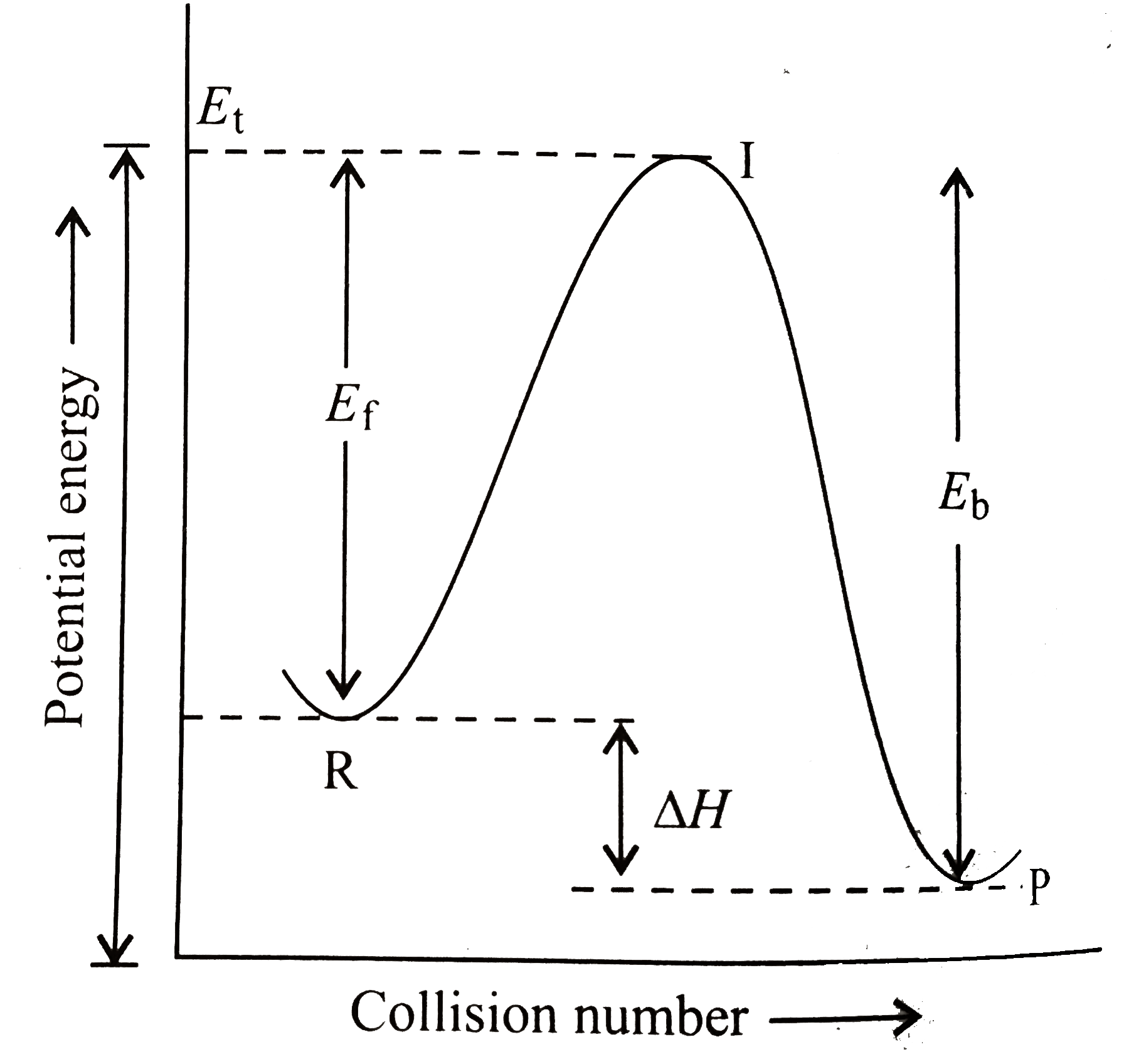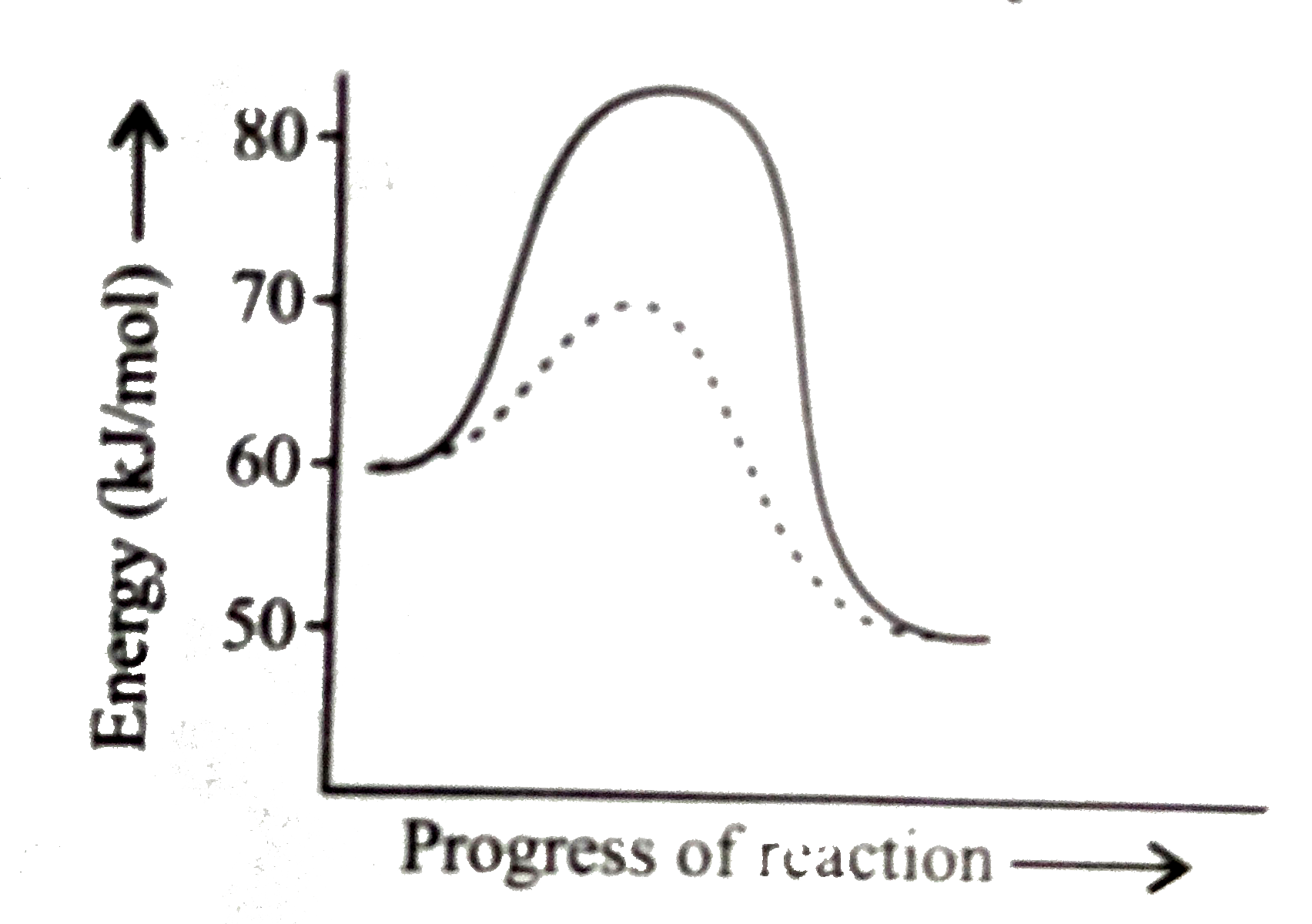For the equilibrium,
A(g)→B(g),ΔH is -40 KJ/mol.
If the ratio of the activation energies of the forward (Ef) and reverse (Eb) reactions is 23 then:
Ef=60 kJ/mol, Eb=100 kJ/mol
Ef=30 kJ/mol, Eb=70 kJ/mol
Ef=80 kJ/mol, Eb=120 kJ/mol
Ef=70 kJ/mol,Eb=30 kJ/mol
The correct Answer is:C
To solve the problem, we need to find the activation energies Ef (forward reaction) and Eb (reverse reaction) given the enthalpy change ΔH and the ratio of the activation energies.
1. Understand the Given Data:
- The enthalpy change ΔH for the reaction A(g)→B(g) is given as −40kJ/mol.
- The ratio of the activation energies is given as EfEb=23.
2. Set Up the Variables:
- Let Ef=X (activation energy of the forward reaction).
- Then, according to the ratio, Eb=32X (activation energy of the reverse reaction).
3. Use the Relationship Between Enthalpy and Activation Energies:
- The relationship between the enthalpy change and the activation energies is given by:
ΔH=Ef−Eb
- Substituting the values we have:
−40=X−32X
4. Simplify the Equation:
- Combine the terms on the right side:
−40=X−1.5X=−0.5X
5. Solve for X:
- Rearranging gives:
−40=−0.5X⟹X=80kJ/mol
- Thus, Ef=80kJ/mol.
6. Calculate Eb:
- Now, substitute X back to find Eb:
Eb=32×80=120kJ/mol
Final Answers:
- Ef=80kJ/mol
- Eb=120kJ/mol
- The enthalpy change ΔH for the reaction A(g)→B(g) is given as −40kJ/mol.
- The ratio of the activation energies is given as EfEb=23.
- Let Ef=X (activation energy of the forward reaction).
- Then, according to the ratio, Eb=32X (activation energy of the reverse reaction).
- The relationship between the enthalpy change and the activation energies is given by:
ΔH=Ef−Eb
- Substituting the values we have:
−40=X−32X
- Combine the terms on the right side:
−40=X−1.5X=−0.5X
- Rearranging gives:
−40=−0.5X⟹X=80kJ/mol
- Thus, Ef=80kJ/mol.
- Now, substitute X back to find Eb:
Eb=32×80=120kJ/mol
- Ef=80kJ/mol
- Eb=120kJ/mol
Topper's Solved these Questions
- CHEMICAL KINETICS BOOK - VMC MODULES ENGLISHCHAPTER - CHEMICAL KINETICS EXERCISE - JEE Advanced (Archive)
52 Videos
- CHEMICAL KINETICS BOOK - VMC MODULES ENGLISHCHAPTER - CHEMICAL KINETICS EXERCISE - Level-2 ( Numerical Value Type for JEE Main )
15 Videos
- CHEMICAL EQUILIBRIUMBOOK - VMC MODULES ENGLISHCHAPTER - CHEMICAL EQUILIBRIUMEXERCISE - IN-CHAPTER EXERCISE - G
10 Videos
- CHEMICAL THERMODYNAMICS BOOK - VMC MODULES ENGLISHCHAPTER - CHEMICAL THERMODYNAMICS EXERCISE - IN - CHAPTER EXERCISE - L
10 Videos
Similar Questions
A+B→C,ΔH=+60 kJ/mol
Eaf is 150 kJ. What is the activation energy for the backward reaction ?
View SolutionIf Ef and Er are the activation energies of forward and backward reactions and the reaction is known to be exothermic, then
View SolutionFor the reaction N2(g)+3H2(g)→2NH3(g),ΔH=−93.6KJmol−1 the formation of NH3 is expected to increase at :
View SolutionH2O(g)→H2O(l),ΔH=−40.7kJ
ΔH is the heat of……………….of water.
View SolutionH2O(l)→H2O(g),ΔH=+40.7kJ
ΔH is the heat of ……………..of water.
View SolutionThe energies of activation for forward and reverse reaction for A2+B2⇔2AB are 180kJmol−1 and 200kJmol−1 respectively. The presence of catalyst lowers the activation energy of both (forward and reverse) reactions by 100kJmol−1. The enthalpy change of the reaction (A2+B2→2AB) in the presence of catalyst will be (in kJmol−1):
View SolutionA colliison between reactant molecules must occur with a certain minimum energy before it is effective in yielding Product molecules. This minimum energy is called activation energy Ea Large the value of activation energy, smaller the value of rate constant k. Larger is the value of activation energy, greater is the effect of temperature rise on rate constant k.

Ef= Activation energy of forward reaction
Eb= Activation energy of backward reaction
ΔH=Ef−Eb
Ef= threshold energy
In a hypothetical reaction A→B, the activation energies for the forward and backward reactions are 15 and 9kJmol−1, respectively. The potential energy of A is 10kJmol−1. Which of the following is wrong?
View SolutionThe activation energy for the forward reaction X→Y is 60kJmol−1 and ΔH is −20kJmol−1. The activation energy for the reverse reaction is
View SolutionIn an exothermic reaction X→Y, the activation energy is 100kJmol−1 of X. The enthalphy of the reaction is −140kJmol−1. The activation energy of the reverse reaction Y→X is

View SolutionFor a reaction A2+B2⇔2AB the figure shows the path of the reaction in absence and presence of a catalyst. What will be energy of activation for forward (Ef) and backward (Eb) reaction in presence of a catalyst and ΔH for the reaction? The dotted curve is path of reaction in presence of a catalyst.

View Solution
